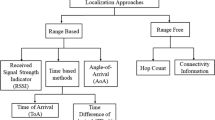Abstract
A distributed local adaptive transmit power assignment (LA-TPA) strategy was proposed to construct a topology with better performance according to the environment and application scenario and prolong the network lifetime. It takes the path loss exponent and the energy control coefficient into consideration with the aim to accentuate the minimum covering district of each node more accurately and precisely according to various network application scenarios. Besides, a self-healing scheme that enhances the robustness of the network was provided. It makes the topology tolerate more dead nodes than existing algorithms. Simulation was done under OMNeT++ platform and the results show that the LA-TPA strategy is more effective in constructing a well-performance network topology based on various application scenarios and can prolong the network lifetime significantly.
Similar content being viewed by others
References
AKYILDIZ I F, SU W, SANKARASUBRAMANIAM Y, CAYIRCI E. Wireless sensor networks: A survey [J]. Computer Network, 2002, 38(4): 393–422.
JENNIFER Y, BISWANATH M, DIPAK G. Wireless sensor network survey [J]. Computer Networks, 2008, 52(12): 2292–2330.
SUNIL J, PRABHAT R. A Survey: Topology control for wireless sensor networks [C]// IEEE International Conference on Signal Processing, Communications and Networking. Chennai: IEEE Press, 2008: 422–427.
HEMPSTEAD M, TRIPATHI N, MAURO P, WEI G Y, BROOKS D. An ultra low power system architecture for sensor network applications [C]// Proceeding of the 32nd International Symposium on Computer Architecture. Madison, WI: IEEE Computer Society Press, 2005: 208–219.
LIU H, ROEDER T, WALSH K, BARR R, SIRER E G. Design and implementation of a single system image operating system for ad hoc networks [C]// 3rd International Conference on Mobile Systems, Applications, and Services. Seattle, WA: USENIX Association Press, 2005: 149–162.
SAJJAD Z, AMIR N, NASSER Y. Efficient construction of network topology to conserve energy in wireless Ad hoc networks [J]. Computer Communications, 2008, 31(1): 160–173.
PENROSE M D. A strong law for the longest edge of the minimal spanning tree [J]. The Annals of Applied Probability, 1999, 27(1): 340–361.
PENROSE M D. On k-connectivity for a geometric random graph [J]. Random Structures and Algorithms, 1999, 15(2): 145–164.
SANTI P, BLOUGH D M. The critical transmitting range for connectivity in sparse wireless ad hoc networks [J]. IEEE Transactions on Mobile Computing, 2005, 2(1): 25–39.
KIROUSIS L, KRANAKIS E, KRIZANC D, PELC A. Power consumption in packet radio networks [J]. Theoretical Computer Science, 2000, 243(1/2): 289–305.
CLEMENTI A, PENNA P, SILVESTRI R. Hardness results for the power range assignment problem in packet radio networks [C]// 2nd International Workshop on Approximation Algorithm for Combinatorial Optimization Problems (RANDO APPRO 99). Berkeley, CA: Springer Press, 1999: 197–208.
ALTHAUS E, CALINESCU G, ANDOIU I, PRASAD S, TCHERVENSKI N, ELIKOVSKY A. Power efficient range assignment in ad hoc wireless networks [C]// IEEE WCNC2003. New Orleans, LA: IEEE Press, 2003: 1889–1894.
LI N, HOU J C, SHA L. Design and analysis of an MST-based topology control algorithm [J]. IEEE Transactions on Wireless Communications, 2005, 4(3): 1195–1206.
LI N, HOU J C. Flss: A fault-tolerant topology control algorithm for wireless networks [C]// Proc of the 10th Annual International Conference on Mobile Computing and Networking, MobiCom’04. New York: ACM Press, 2004: 275–286.
LI N, HALPERN J Y, BAHL P. A cone-based distributed topology control algorithm for wireless multi-hop networks [J]. IEEE Transactions on Networking, 2005, 13(1): 147–159.
BORBASH S A, JENNING E H. Distributed topology control algorithm for multihop wireless networks [C]// Proc IEEE International Joint Conference on Neural Networks. Honolulu, HI: IEEE Press, 2002: 355–360.
ROGER W, AARON Z. XTC: A practical topology control algorithm for ad hoc and sensor networks [C]// 18th International Parallel and Distributed Processing Symposium. New Mexico, 2004: 216–223.
LIU Li, LI Lian, HU Bin. Algorithms for k-fault tolerant power assignments in wireless sensor networks [J]. Science China Information Sciences, 2010, 53(12): 2527–2537.
INDRANIL S, LOKESH K S, SUBHAS K G, RANJEET K P. Distributed fault-tolerant topology control in wireless multi-hop networks [J]. Wireless Networks, 2010, 16(6): 1511–1524.
ANEJA Y P, CHANDRASEKARAN R, XIANGYONG L, NAIR K P K. A branch-and-cut algorithm for the strong minimum energy topology in wireless sensor networks [J]. European Journal of Operational Research, 2010, 204(3): 604–612.
LIU Hai-tao, ZHANG Bao-xian, ZHENG Jun, HUSSEIN T M. An energy-efficient localized topology control algorithm for wireless ad hoc and sensor networks [J]. International Journal of Communication Systems, 2008, 21(11): 1205–1220.
LI De-ying, DU Hong-wei, LIU Lin, HUANG S C. Joint topology control and power conservation for wireless sensor networks using transmit power adjustment [C]// 14th Annual International Conference on Computing and Combinatorics. Dalian, China: Springer Press, 2008: 541–550.
HARISH S, THOMAS G. A new distributed topology control algorithm for wireless environments with non-uniform path loss and multipath propagation [J]. Ad hoc Networks, 2010, 8(3): 280–294.
SANTI P. Topology control in wireless Ad hoc and sensor networks [J]. ACM Computing Surveys, 2005, 37(2): 164–194.
NARAYANASWAMY S, KAWADIA V, SREENIVAS R S, KUMAR P R. Power control in ad hoc networks: Theory, architecture, algorithm and implementation of the COMPOW protocol [C]// Proc of the European Wireless Conf. Florence: Springer Press, 2002: 156–162.
TOUSSAINT G T. The relative neighborhood graph of a finite planar set [J]. Pattern Recognition, 1980, 12(4): 261–268.
Author information
Authors and Affiliations
Corresponding author
Additional information
Foundation item: Projects(61101104, 61100213) supported by the National Natural Science Foundation of China; Project(NY211050) supported by Fund of Nanjing University of Posts and Telecommunications, China
Rights and permissions
About this article
Cite this article
Zhao, Xj., Zhuang, Y. & Wang, J. Local adaptive transmit power assignment strategy for wireless sensor networks. J. Cent. South Univ. 19, 1909–1920 (2012). https://doi.org/10.1007/s11771-012-1225-9
Received:
Accepted:
Published:
Issue Date:
DOI: https://doi.org/10.1007/s11771-012-1225-9




